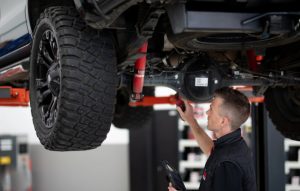Many drivers think of tire wear as an issue related solely to alignment or tire quality. While these are important factors, suspension components, especially shock absorbers, play a vital and often overlooked role in determining how evenly — and how quickly — your tires wear out.
In this article, we’ll explore how worn or failing shock absorbers can accelerate tire wear, the warning signs to look out for, and how maintaining your suspension system can extend the life of your tires.
What Do Shock Absorbers Actually Do?
Shock absorbers, or dampers, are critical parts of the suspension system. Their primary function is to control the movement of the springs and minimize oscillations after your vehicle hits a bump or dips in the road. Without them, your car would bounce uncontrollably, making for an unsafe and uncomfortable ride.
How Shock Absorbers Affect Tire Wear

Shock absorbers help keep your tires in consistent contact with the road. When they fail or wear out, that contact becomes irregular — leading to uneven pressure distribution, poor traction, and ultimately, faster tire degradation.
Here’s how worn shock absorbers contribute to specific patterns of tire wear:
| Tire Wear Pattern | Caused by Shock Absorber Issue | Description |
|---|---|---|
| Cupping/Scalloping | Bouncing tires due to lack of damping | Dips or scalloped patches across the tread |
| Feathering | Uneven suspension recovery | Tread blocks worn more on one side than the other |
| Accelerated Outer Wear | Excessive body roll in corners | Outside edge wears down faster |
| Patchy Wear | Inconsistent road contact | Random high and low tread spots |
The Physics Behind It
When a vehicle hits a bump, the suspension compresses, and the shock absorber dampens the rebound. If the shock is worn out:
-
The tire rebounds forcefully, reducing road grip.
-
The tire may lift briefly off the road.
-
During braking or cornering, the vehicle leans more, overloading specific areas of the tire.
This results in localized friction, generating heat and increasing tread wear.
Signs Your Shock Absorbers May Be Affecting Tire Life
Your tires could be telling you something about your suspension system. Look for these warning signs:
-
Tires showing scalloping or cupping
-
Uneven tread depth between the inside and outside
-
Vehicle dips or dives when braking
-
Excessive bouncing over bumps
-
Knocking or clunking sounds from suspension
-
Steering feels loose or unstable at speed
If you observe any of these symptoms, your shock absorbers could be at the end of their life.
Suspension Maintenance and Tire Longevity
Keeping your suspension system in good shape isn’t just about ride comfort — it’s also a financial decision. Tires are expensive, and improper suspension can cut their lifespan by 20–40%.
Tips to Maximize Tire Life Through Suspension Care:
-
Inspect shocks and struts every 20,000–30,000 km
-
Replace shocks around 80,000–100,000 km (depending on vehicle and driving style)
-
Rotate tires every 8,000–12,000 km
-
Balance and align wheels regularly
-
Avoid overloading your vehicle
-
Drive carefully over potholes and rough roads
When to Replace Shock Absorbers

You should consider replacing your shock absorbers when:
-
There is visible fluid leakage
-
You hear rattling or knocking
-
The ride becomes bouncy or unstable
-
There’s uneven tire wear that isn’t solved by alignment or balancing
Timely replacement improves tire performance and helps maintain safe handling.
Replacement Options: Hydraulic, Gas, or Adaptive?
If you’re due for new shock absorbers, choosing the right type is essential:
| Type | Features | Ideal For |
|---|---|---|
| Hydraulic | Basic damping, affordable | Economy cars, daily driving |
| Gas-Charged | Enhanced control, less fade | High-speed or sporty driving |
| Adaptive/Electronic | Adjustable in real-time, premium comfort | Luxury and performance vehicles |
Not sure what fits your car best? Consult your owner’s manual or a trusted mechanic. Where to buy Shock Absorbers?
How Shock Absorbers Complement Tire Technology
Modern tires are designed with advanced compounds and tread patterns to improve grip and reduce rolling resistance. But without effective shock absorption:
-
These benefits are compromised
-
Braking distances increase
-
Tire tread wears unevenly
-
Ride noise and vibration rise
So, keeping your shocks healthy means getting the most out of your tire investment.
Final Thoughts
Your tires are your only point of contact with the road — and shock absorbers play a crucial role in how well they perform and how long they last. By maintaining your suspension system and replacing shock absorbers when needed, you not only enhance ride quality but also extend the lifespan of your tires significantly.
Ignoring suspension wear today can lead to tire replacement tomorrow. Don’t wait for bald spots and bumpy rides — stay ahead with regular inspections and timely replacements.
If you’re looking for top-quality parts that fit your vehicle, check out Where to buy Shock Absorbers?